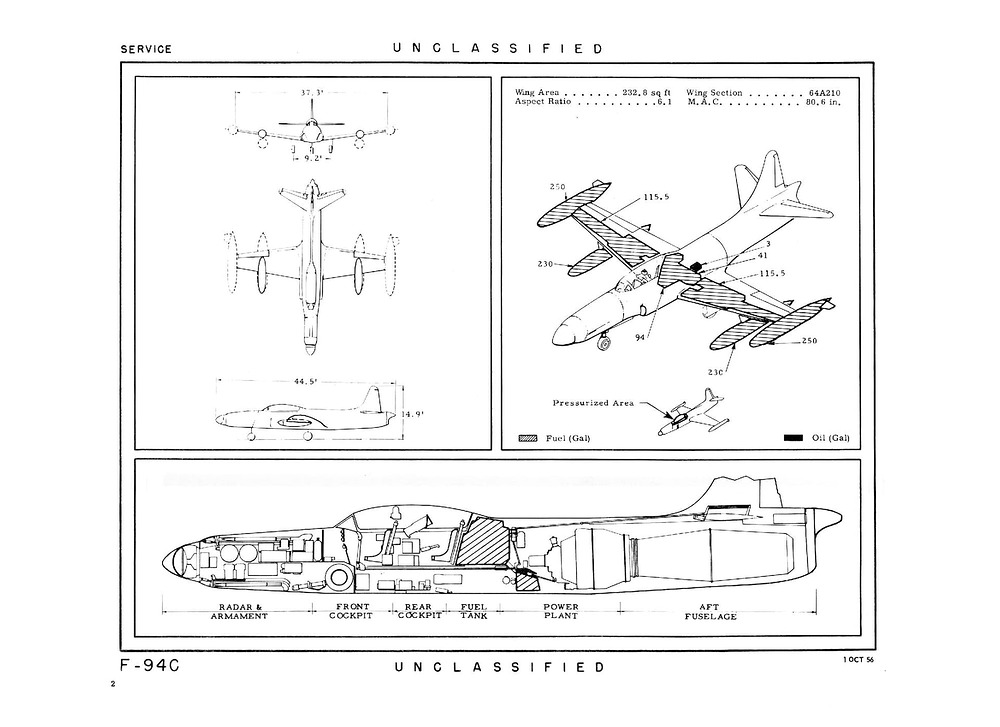- Yes
- No
- Tech Tree
- Premium
- Event
- Squadron
- I said no
Overview
The F-94C was actually the second version of the F-94 developed, though the third to enter production and service. Originally designated the F-97, the F-94C was dramatically different from the F-94A/B, with a much more powerful engine and an all-rocket armament similar to the F-89D.
History
Expand
F-94 Origins
The F-94 was developed in 1948 in response to the Tu-4 as a simple jet-powered interceptor with the goal of entering service as quickly as possible by using as many existing components as possible. To accomplish this, Lockheed modified the T-33A trainer, a twin-seat version of the F-80, to mount a radar and armament in the nose and feature an afterburner. The F-94 made its first flight in April 1949, with production starting in December that year and the type entering service in early 1950. This made the F-94 the US’s first afterburning aircraft and the first all-weather and night-combat capable jet aircraft in USAF service.
The F-94C
Development of the F-94C began in 1949. Originally designated the F-97A, it was intended to be a separate aircraft from the F-94, though the two shared most of their components. The F-94C featured the new J48-P-5 engine which was considerably more powerful than the J33 as well as thinner wings, both intended to increase top speed. Control surfaces were redesigned for better handling at high mach numbers. The F-94C also featured increased fuel capacity for longer range. The machine gun armament of the F-94A/B was found to be insufficient against bombers, so the F-94C was to be armed with FFAR rockets instead of guns. This armament was paired with a new AN/APG-40 radar and E-5 FCS, intended to be more reliable than the AN/APG-33 and E-1 of the F-94A/B.
Initially, the USAF had little interest in the F-94C. However, after the first flight of the prototype in January 1950, 180 of the type were ordered. Production began in July 1951 after a number of teething troubles. Technically, the F-94C was the only variant officially designated the Starfire, the rest lacking any additional official designation besides their number.
Production and Service
387 F-94Cs were produced from 1951, with the first examples entering service in June 1953. Initially, it had a number of problems with the armament, the most troubling being the tendency for the engine to flame out when the nose rockets were fired. However, these issues would be resolved by 1954 and the aircraft proved highly reliable like the A and B. The F-94C primarily served state-side, though a small number were stationed in Japan. Unlike the F-94A and B, the C never saw combat. The F-94C saw some improvements to its design over the years. Avionics and the ejection seats were upgraded in the mid-50s, and the initial armament of 24 FFARs in the nose was complemented by an additional 24 in wing-mounted pods, bringing the total to 48.
The F-94C holds the distinction of the first all-weather aircraft to break Mach 1, doing so in a steep dive from 45,000 feet. Overall, the service life of the F-94C was short and uneventful, the type being removed from service in 1959, having been replaced by more capable aircraft. There were tests to integrate the GAR-1 (AIM-4) Falcon on the F-94C platform, but nothing came of the program.
Specifications
Expand
Airframe
Length: 12.2m
Span: 11.9m
Height: 3.9m
Wing area: 21.6m^2
Min wing loading: 267kg/m^2
Empty weight: 5,764kg
Loaded weight: 6,638kg
Combat weight: 8,015kg
MTOW: 10,970kg
Propulsion
1x J48-P-5A afterburning turbojet
Max thrust, dry: 28.2kN
Max thrust, afterburning: 38.9kN
Max TWR (WEP): 0.69
Max internal fuel: 3,278L
Max external fuel: 2x 871L drop tanks (wingtips), 2x 946L drop tanks (underwing)
2x 12AS-1000D-4 RATO boosters (under-fuselage)
Thrust: 4.4kN (each)
Burn time: 12 seconds
Weight: 200lb each
Performance
Max speed (sea level): 1,052km/h (Mach .85)
Max climb rate: 60m/s, clean, sea level
Max g loading: 7.33g
Armament
24x FFAR, nose-mounted
24x FFAR, wing-mounted
2x 100, 250, 500, or 1000lb bombs, wingtip-mounted
2x 250gal fuel tanks, wingtip-mounted
2x 230gal fuel tanks, wing-mounted
AN/APG-40 search and track radar
The F-94C in game
Expand
The F-94C’s more powerful engine gives it a huge advantage over the A/B. However, the armament is rather ineffective against fighters except in a head-on. Compared to the F-89D, the F-94 is slightly faster and has nearly double the climb rate as well as likely better energy retention with its smaller wings and more powerful engine. However, it also has only half the rockets at 48. Overall, with its unusual and unconventional design I believe it would fit best as a premium or event vehicle around BR 7.3.
Gallery
Spoiler
The F-94C can be easily differentiated from the F-94A/B by its double-cone nose shape. The painted sections fold inwards when the rockets are fired, as seen on this aircraft
F-94C with its rockets exposed
The F-94C with rocket pods

Each pod contained a dozen rockets, doubling the total amount carried by the F-94C
Reloading the F-94C

Cool livery
Several F-94Cs in formation
F-94C firing. Aircraft would sometimes only carry rockets in the pods due to partially unresolved engine flameout issues when firing the nose rockets
The F-94C having its aerodynamic cone added to the rocket pods, as the caption describes this was ejected upon firing

Inside the fore and rear cockpits
This F-94C has all its fuel tanks attached

F-94C layout
Sources
Expand
T.O. 1F-94C-1 F-94C Flight Handbook
F-94C Starfire Standard Aircraft Characteristics - 1 October 1956
Lockheed F-94 Starfire (historyofwar.org)
Lockheed F-94 Starfire - fighter (aviastar.org)
F-97A / F-94C Starfire
Lockheed F-97/F-94C Starfire
Check out the other members of the F-94 family!
F-94A
F-94B
F-94D









